The Planning module in Odoo 18 is a key real-time scheduling solution that empowers businesses to organize, assign, and monitor workforce activities across departments, projects, and locations. Odoo Resource Planning is more than just a shift calendar; it’s a centralized planning documentation engine that helps companies optimize human resource allocation, coordinate availability, and align capacity with operational demand in a way that’s both structured and dynamic.
With real-time synchronization and built-in flexibility, even complex, multi-departmental teams remain aligned and responsive. Whether you’re scheduling a field team, managing a manufacturing floor, or coordinating a consulting operation, the Odoo Planning Module adapts to your scheduling logic. Its flexibility supports diverse industries, from retail to Odoo production planning, enabling businesses to align their workforce with operational goals. By centralizing planning documentation, it eliminates time-consuming manual coordination and gives managers clear visibility into workload trends. This enables faster, more strategic staffing decisions. It transforms resource planning from reactive firefighting into a proactive, insight-driven process.
In this tutorial, we’ll explore how the Odoo Planning App enables smarter resource and Odoo capacity planning through real-time insights and seamless integration with operations. With mobile access through the Odoo app, managers and employees can stay updated on schedules and shifts anytime, anywhere — ensuring continuous alignment across teams.
Benefits of Odoo Planning App for Shift Scheduling
The Odoo Planning Module is a smart coordination hub for managing real-world resources that adapts to the fast-changing demands of daily operations. Whether you’re managing hourly workers, warehouse staff rotations, or long-term project teams, this flexible shift planning application helps bring structure to operational chaos by visualizing availability, tasks, shifts, and deadlines in one unified timeline. Integrated with other planning modules like Time Off, Projects, and even Odoo MRP planning, it supports everything from production scheduling to field service dispatching. As a result, businesses can reduce scheduling conflicts, improve resource utilization, and ensure teams are always aligned with operational priorities.
Shift Planning for
Retail and Manufacturing
Odoo Planning simplifies shift planning for warehouses and manufacturing facilities by allowing managers to assign employees to specific shifts, machines, or production lines by dragging and dropping assignments directly into the shift timeline. Features like recurring schedules and predefined templates ensure balanced shift coverage, making Odoo manufacturing planning more efficient and error-free. For example, a factory manager can assign operators to specific production lines, ensuring no machine is understaffed during peak hours.
Shift
Planning Application & Management
In service-based industries, Odoo shift management excels by allowing managers to allocate staff based on skill sets, certifications, or geographic proximity. The module’s filtering tools let you identify available personnel by role or location, assign them to customer appointments, and send instant notifications via email or the Odoo Planning App. This is critical for businesses where missed or delayed visits lead to poor customer experiences or breaches of service-level agreements.
Open Resource Planning Application
A project-based organization with an open planning project requires precise resource visibility to meet tight deadlines. By tracking the difference between forecasted and actual workloads, businesses can optimize staff utilization and maintain long-term workload balance. This is ideal for agencies, software development teams, or construction firms that need robust Odoo project planning to manage complex timelines and resource constraints
Vacation- and
Absence-Aware Odoo Planning
The Odoo production planning integrates seamlessly with the Time Off module, automatically syncing absences and vacations into the schedule. Team leads can filter by availability, ensuring only eligible staff appear in the shift pool. This feature protects work-life balance and keeps Odoo planning grounded in real-world constraints, making it a vital tool for employee-friendly scheduling.
Smart Planning with Odoo Resource Management
The Odoo Planning Module in version 18 delivers a robust set of features tailored for efficient workforce and shift planning as an open-source, universal solution. Its intuitive drag-and-drop interface enables planners to quickly assign, split, or adjust shifts across teams, projects, or time periods, while real-time integration with the Time Off module prevents scheduling conflicts. Role-based allocation allows managers to assign shifts based on skill sets or job functions rather than individual names, streamlining large-team coordination. Built-in templates and recurring shift patterns minimize manual scheduling, while dynamic calendar views enhance cross-departmental visibility and coordination. Whether used for retail staff rotations, field service dispatching, or as a complete resource planning and management documentation application, the planning module centralizes coordination in a single interface.
- To enable Odoo planning capabilities, navigate to Apps and activate the Odoo Planning Module, as shown in the screenshot.
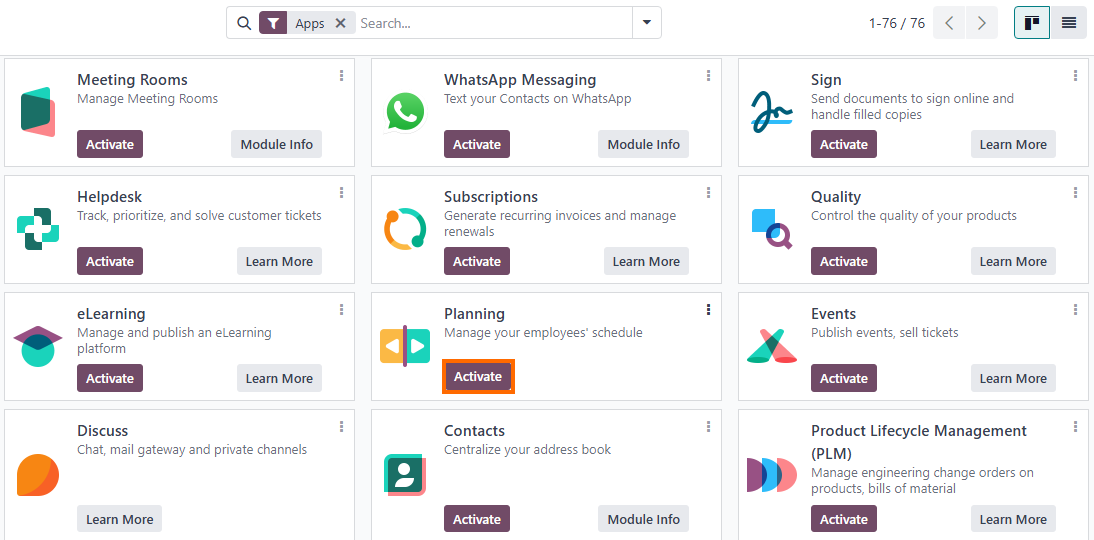
Visual Odoo Planning Interface and Smart Controls
In the main dashboard of the Planning module, users are greeted with a clean, visual interface that supports both strategic resource planning application and reactive shift adjustment. The left-side panel gives access to key Odoo planning views – Gantt, Calendar, and filter by roles, employees, or projects – allowing managers to toggle between high-level capacity overviews and granular shift-by-shift control. Whether you’re building long-term schedules or responding to daily operational changes, the interface adapts to your logic. Drag-and-drop functionality lets you move, reassign, or edit shifts directly on the screen — no context switching needed. Use recurring templates to accelerate routine Odoo resource planning, filter by availability or job title to avoid conflicts, and rely on built-in Time Off sync to ensure assignments reflect real-life constraints.
- Use Odoo planning features that align with your operational goals. These features provide the flexibility to structure and customize your workforce planning according to your specific business needs.
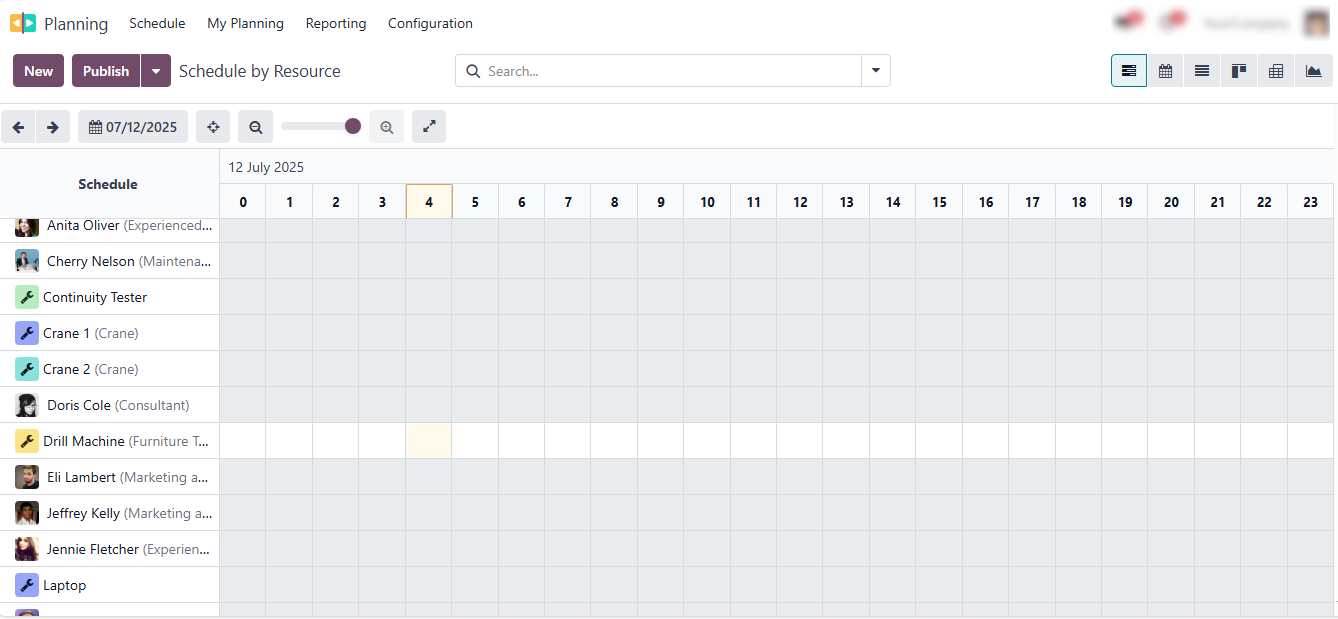
Manual Odoo Scheduling:
Real-World Example
Odoo Planning Module offers a modern and intuitive approach to workforce scheduling, replacing cluttered spreadsheets with visual, interactive tools that adapt to real business needs. The following example illustrates a real-life case of manual Odoo planning — where a manager builds the schedule manually using Gantt view, editing shifts by hand, and adjusting based on live constraints like leave, workload, or skills. While automated scheduling works well for repetitive workflows, manual planning remains crucial in dynamic environments where flexibility and human judgment matter most. This flexibility makes the Planning Module not only an Odoo scheduling tool but also a live coordination tool that evolves in sync with your operations. In industries like consulting, events, or healthcare, where last-minute changes are inevitable, manual Odoo planning provides the agility needed to adapt without disrupting overall project flow.
- Users can easily modify assignments directly within the Gantt chart by clicking the “Edit” button, enabling quick updates to shifts, or reassign personnel without leaving the view.

- Click "New" to add a shift or assignment and use Odoo planning predefined templates to streamline data entry and speed up the process.
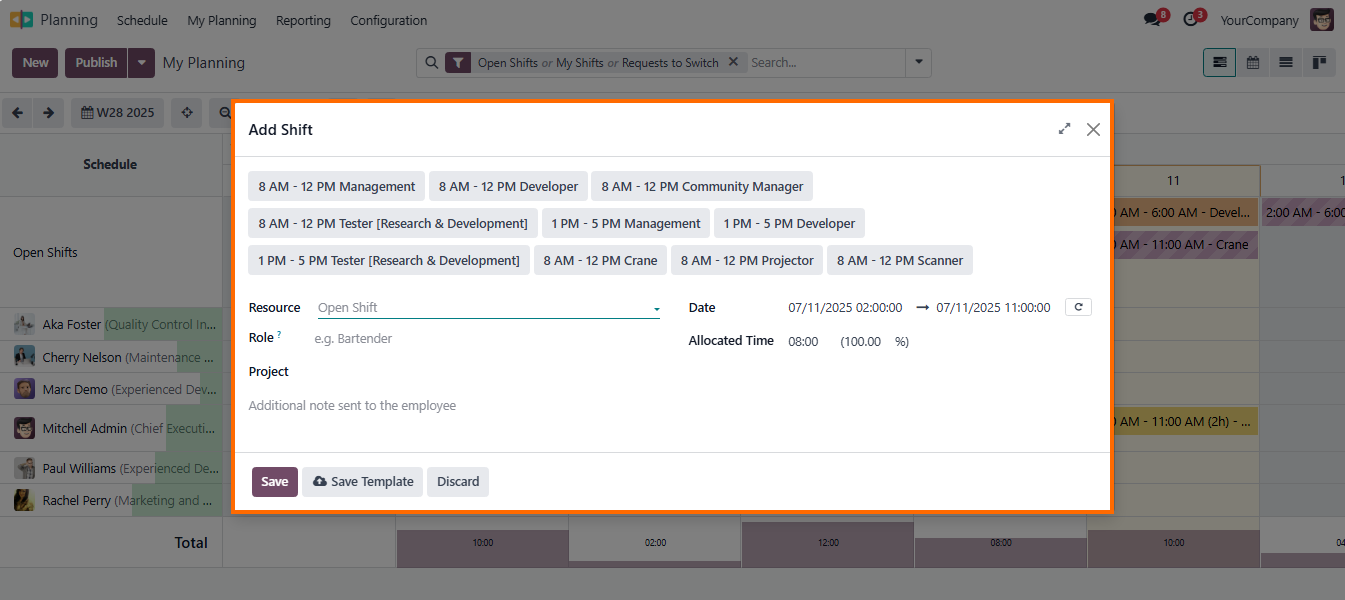
- The Odoo planning calendar integrates with user availability, so it automatically factors in holidays, time off, and other constraints.
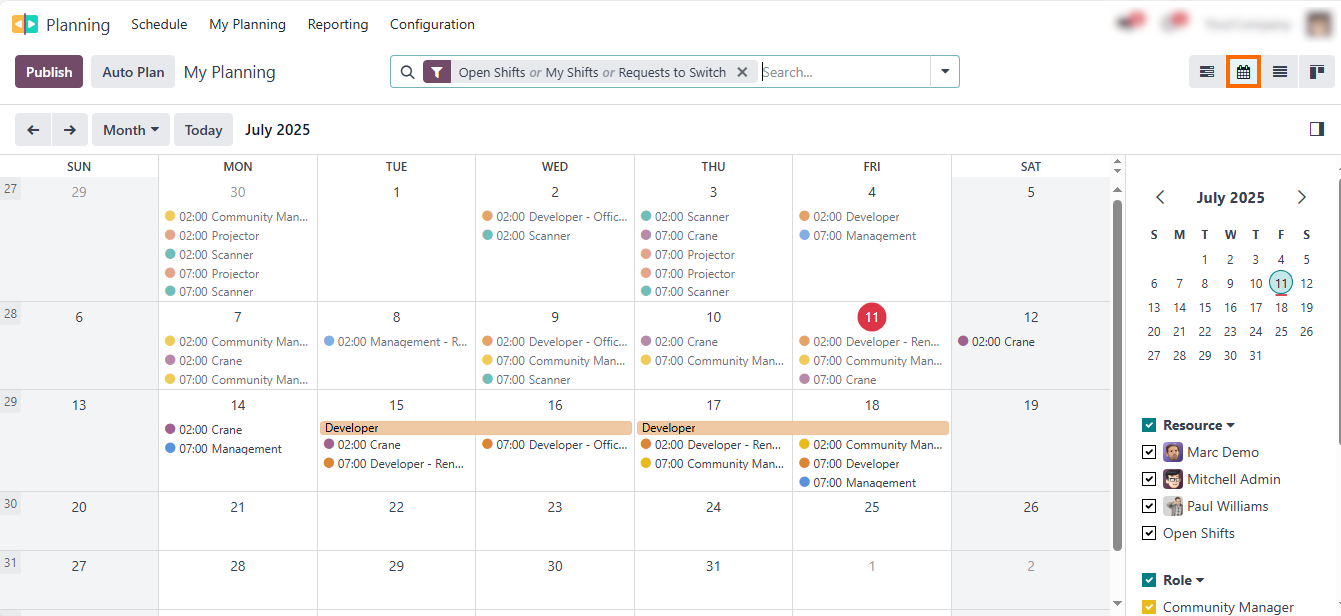
- To see full employee availability, use the graph view, as shown in the screenshot.
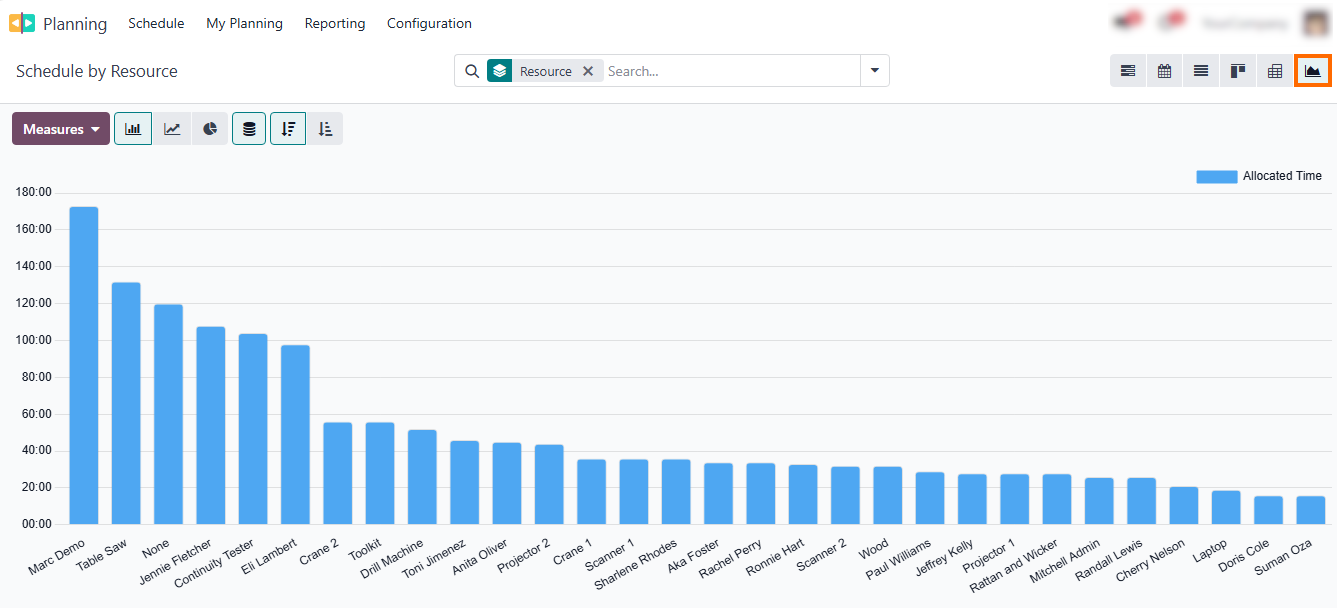
Automated Odoo Scheduling: Real-World Workflow
In real-world operations, planning workflows rarely follow a one-size-fits-all pattern. Some businesses prioritize full control over shift assignments, while others aim for maximum automation to save time and reduce manual coordination. That’s why the Odoo Planning Module supports both Manual and Automated Odoo Scheduling – two complementary approaches that empower companies to build flexible, scalable, and adaptive workforce Odoo plan strategies. Below, we’ll demonstrate two real-life scenarios. One demonstrates automated Odoo shift planning, the other — manual shift planning to highlight how businesses can leverage Odoo planning features across different operational setups.
- Automated Odoo Planningleverages predefined rules, templates, and role-based logic to auto-assign work based on availability, skills, or location. Click the Auto Plan button to apply.
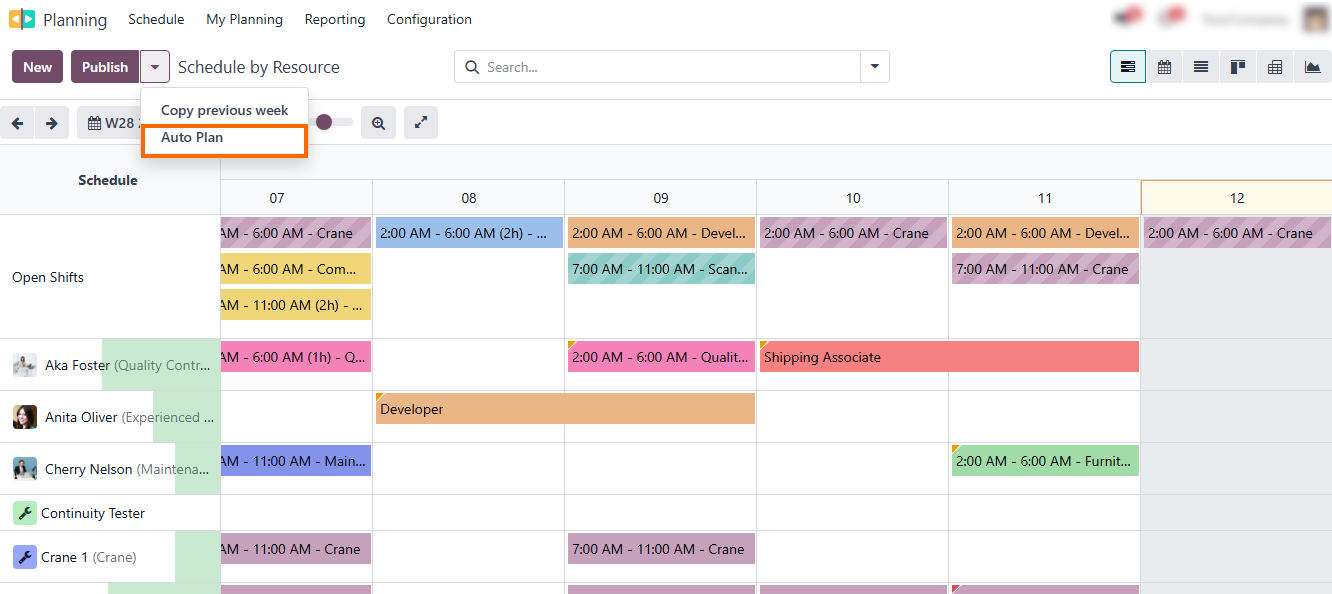
- The system automatically assigns shifts according to each employee’s contract, location, and declared unavailability. Then, managers reviewed and approved.
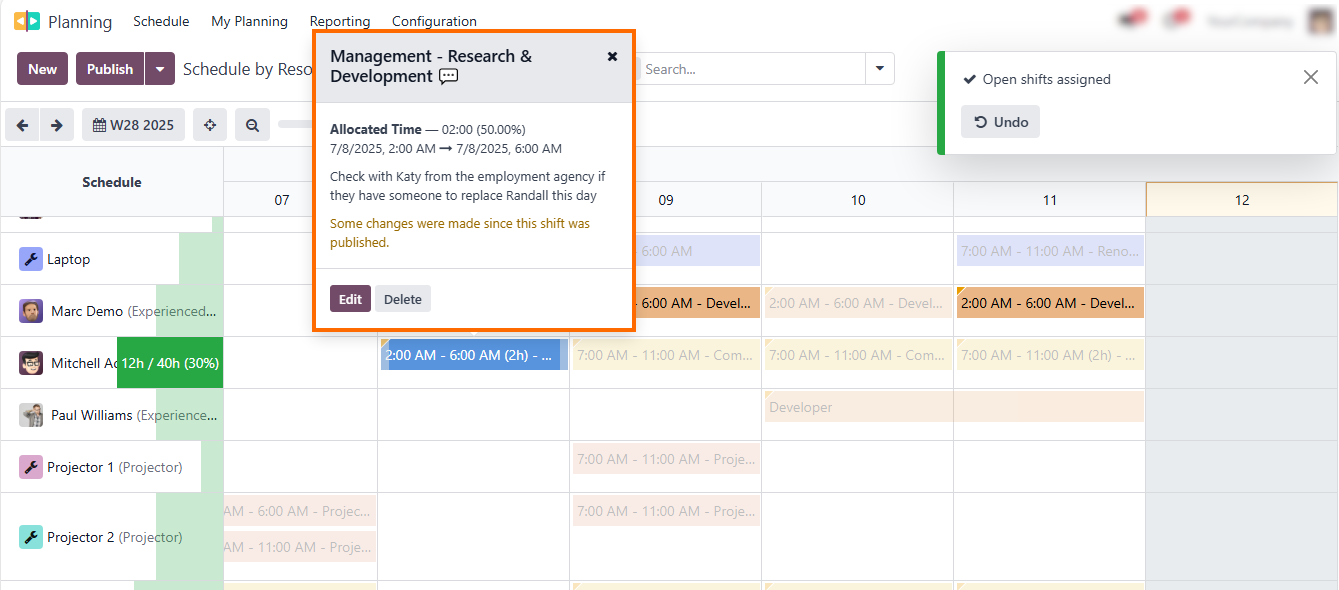
- Cancel all changes by clicking the "Undo" button, instantly reverting the Odoo scheduling to its previous state.
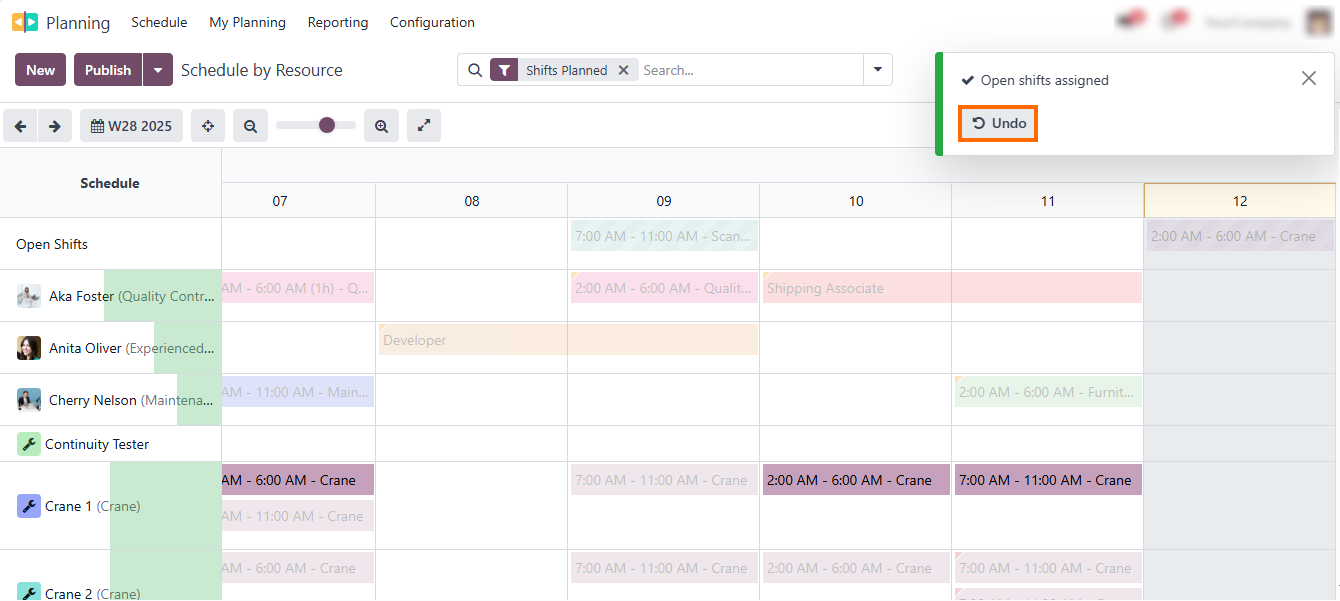
Tips,
Best Practices & Common Pitfalls in Odoo
Planning
Even with powerful features like Odoo planning, effective use of Odoo plan tools depends not just on features, but on how you use them. From aligning roles with shift templates to managing sudden changes without chaos, there are proven approaches that can help teams make the most of the module while avoiding typical mistakes, such as double-bookings, skill mismatches, or underused capacity. A thoughtful Odoo manufacturing planning strategy not only ensures full coverage but also boosts team morale by preventing last-minute rescheduling and burnout. Regularly reviewing your Odoo project documentation data helps identify bottlenecks, optimize resource allocation, and refine Odoo scheduling patterns and Odoo capacity planning over time. Ultimately, the key to successful Odoo planning lies in combining automation with continuous human oversight – ensuring that the system adapts as your teams and business grow.
- Before assigning individual shifts, define roles and use recurring templates to build consistency across weeks or teams. This makes workforce scheduling faster and more scalable.
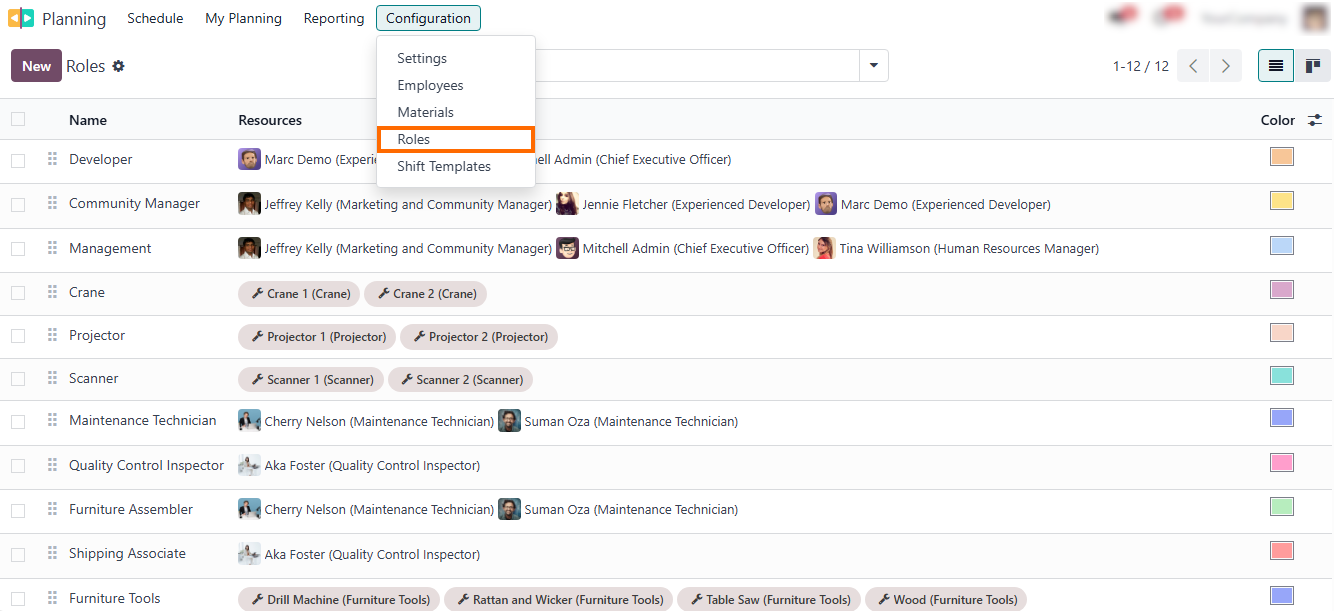
- Ensure that the Time Off module is fully updated before planning. Unapproved or outdated leave data is one of the most common causes of Odoo scheduling conflicts.
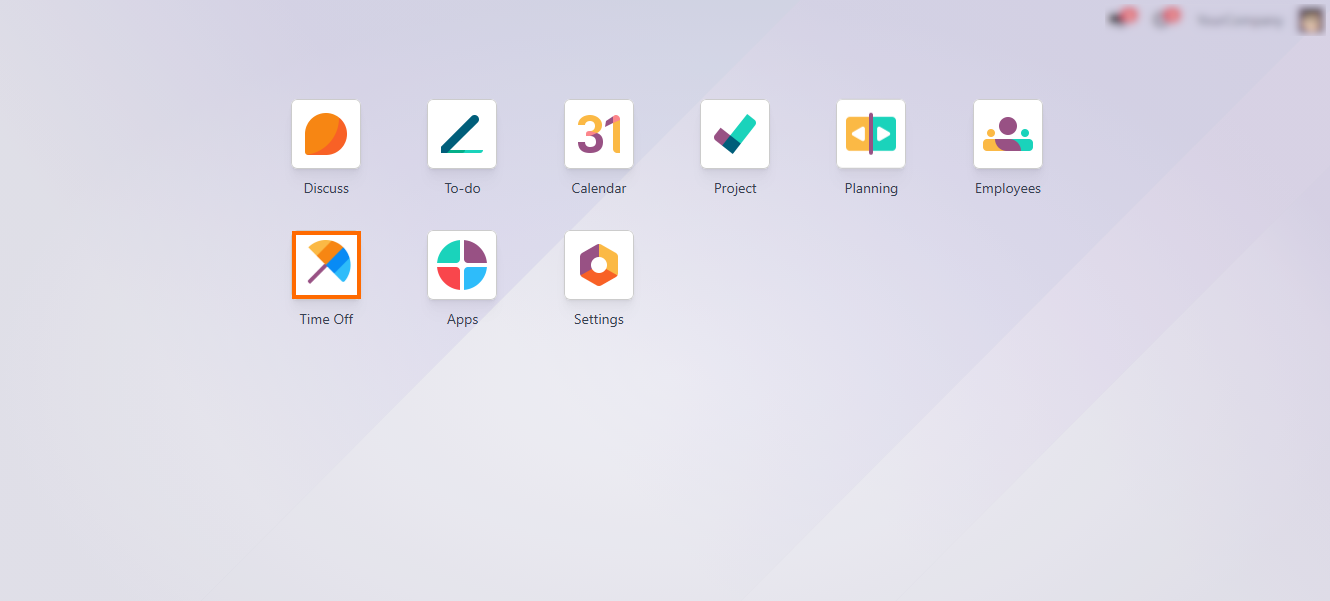
- Filter by job title, project, or location when managing large teams. All this avoids clutter and keeps your focus sharp.

- Review Capacity Weekly by using the Gantt view to check for underutilized or overloaded employees and balance as needed.
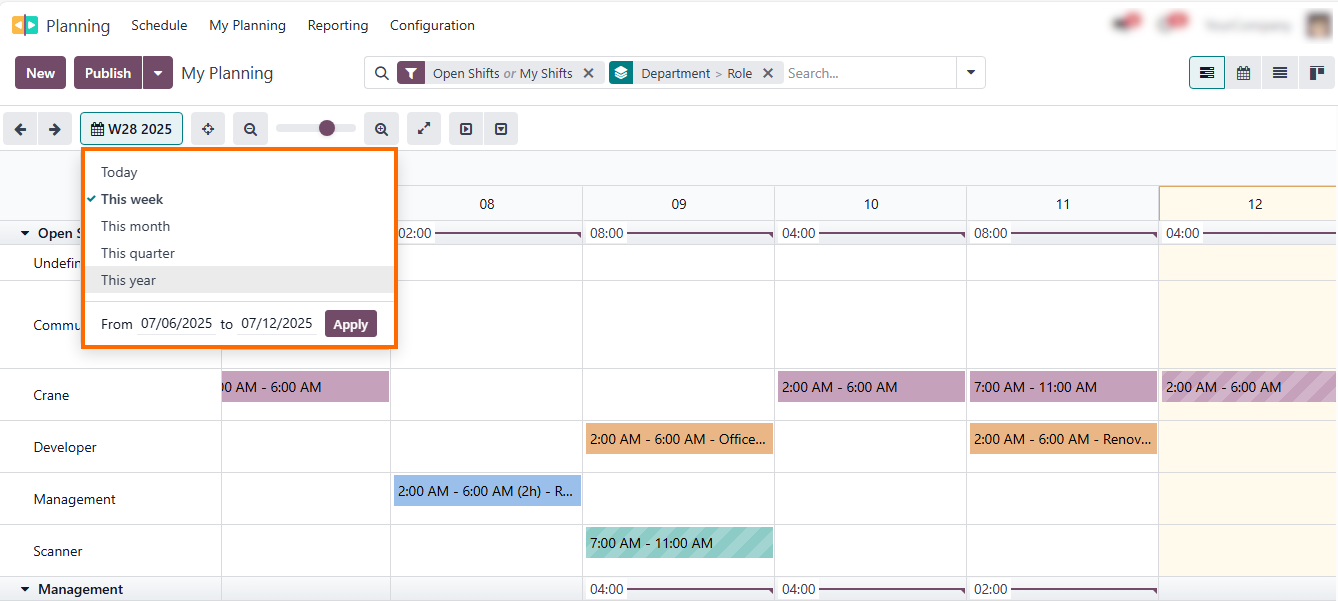
Reporting & Analytics in Odoo Planning
With built-in reporting of Odoo capacity planning, managers can track planned and actual hours, analyze employee workload distribution, and identify scheduling inefficiencies over time. Monitor utilization rates and identify trends across weeks or projects to improve long-term planning. Filters and groupings allow managers to drill down into trends over time — whether they’re identifying seasonal fluctuations, understanding which teams are constantly over Odoo capacity planning, or comparing productivity across departments. Reporting also supports better forecasting for payroll and resource planning. Exportable reports can feed directly into HR and accounting workflows, helping stakeholders make data-informed decisions across functions. By providing a deep overview of planning and centralizing this data, Odoo planning provides a unified view of operational capacity that supports strategic planning operations and resource alignment.
- Slice data by employee, role, project, or department to spot gaps and balance workloads.
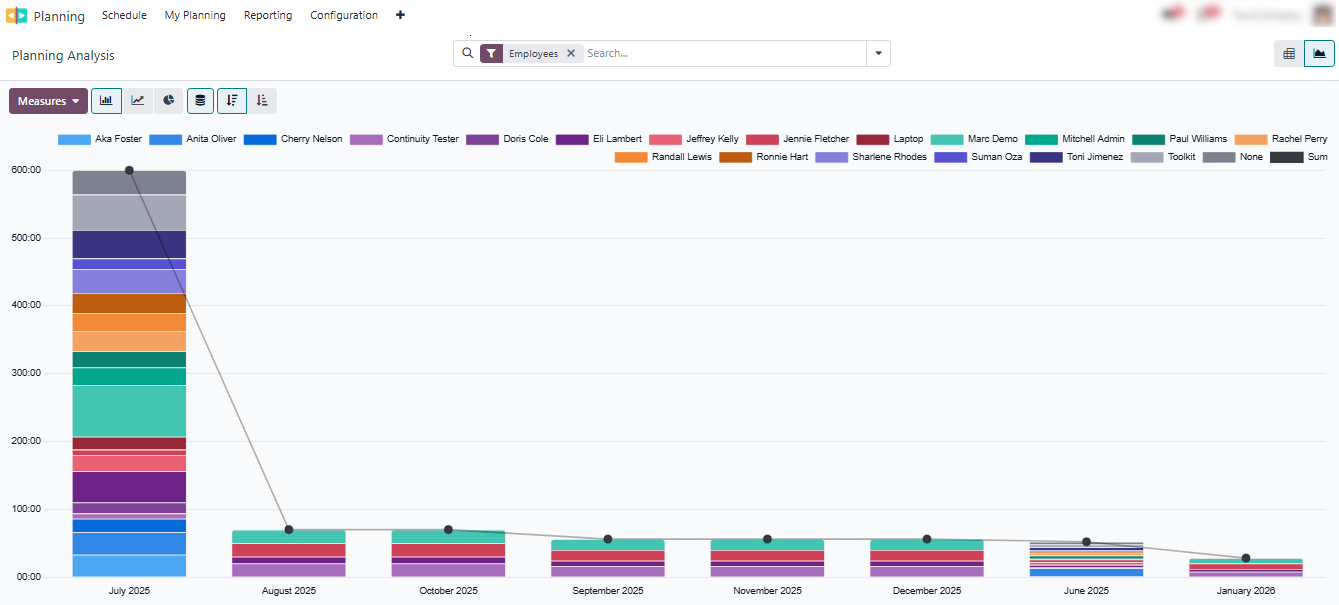
- Filters help managers track trends in Odoo planning, like seasonal shifts or overloaded teams.
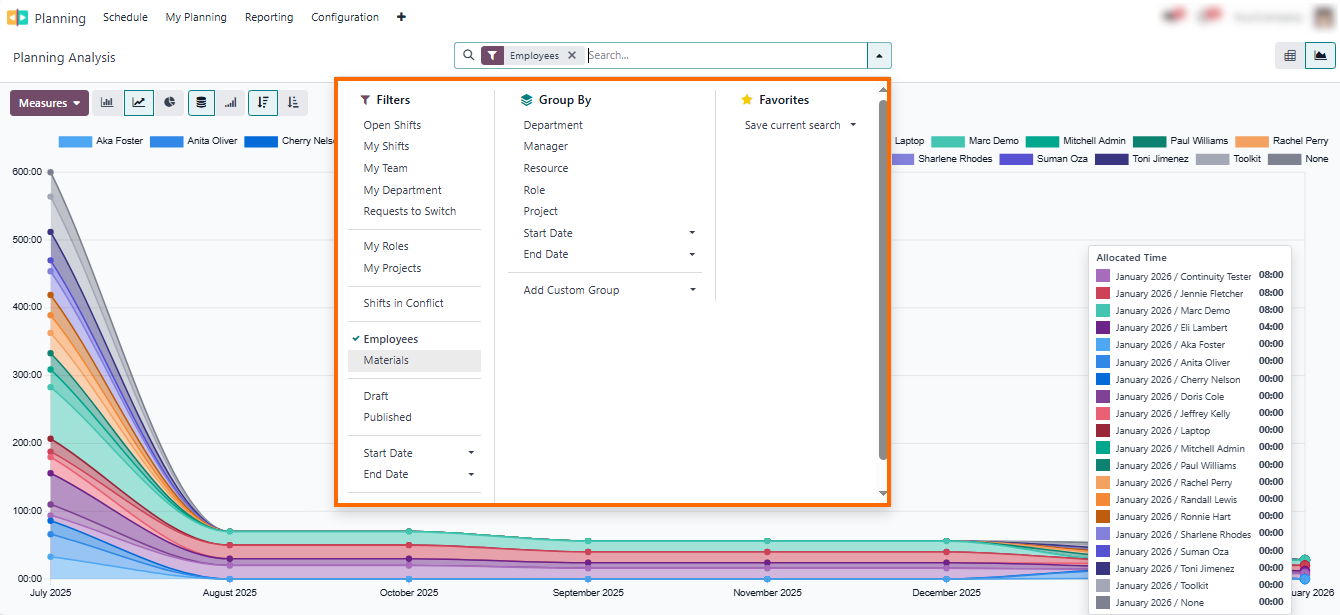
Planning Documentation as a Strategic Layer of Resource Management
Planning documentation in Odoo 18 is more than just a static record – it’s a dynamic, centralized system that transforms how organizations approach resource planning and scheduling. By capturing every shift, task, and availability update in real time, Odoo Planning builds a living resource planning and management documentation layer that drives smarter decisions. Whether managing a production floor or coordinating a remote team, up-to-date Odoo project documentation gives managers full visibility into workload trends, capacity bottlenecks, and cross-functional demands. Unlike spreadsheets or third-party tools, this integrated Odoo planning documentation ensures that every assignment is backed by context: skills, time off, project priorities, and operational constraints. Combined with powerful tools like Odoo scheduling, role-based assignment, and forecast tracking, this documentation becomes a strategic engine that scales with your business.
- Export the planning documentation to Excel or PDF for easy sharing, reporting, or offline use.
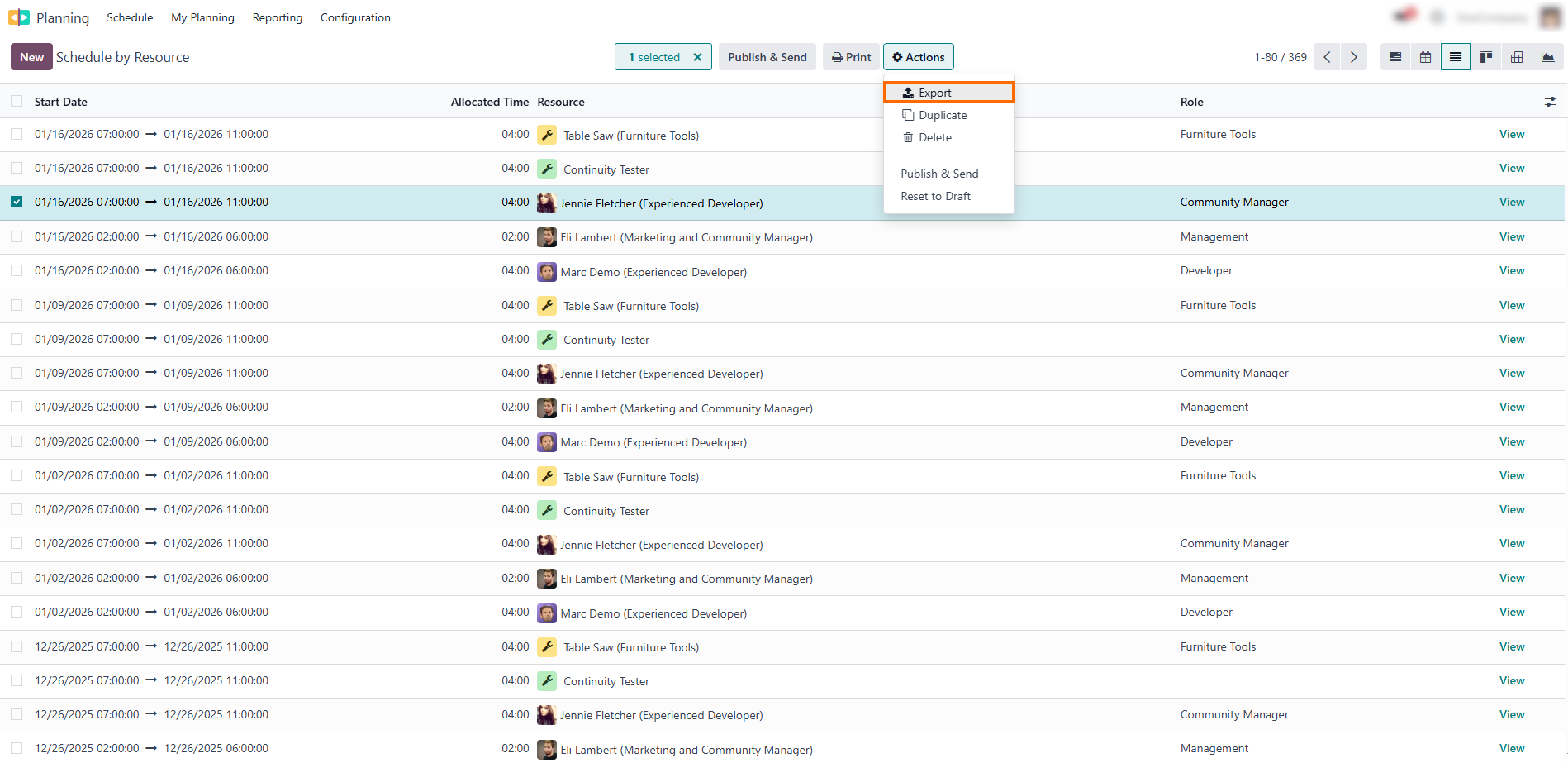
From Mobile Access to Odoo Planning
It’s worth noting that in today’s fast-paced work environments, planning Odoo doesn’t always happen behind a desk. The Odoo Planning Mobile App is designed to support managers and teams wherever the work takes them. Whether you’re walking the shop floor, coordinating a project on-site, or managing field operations, the app provides real-time access to schedules, employee availability, and planning tools from any smartphone or tablet. Managers can assign shifts, approve leave, and respond to absences instantly through a clean and familiar interface. Odoo Planning empowers managers with 24/7 mobile access to real-time scheduling, enabling fast decisions, seamless coordination, and uninterrupted operations across teams, shifts, and locations. Employees can check their assignments, receive push notifications, and stay updated throughout the day. With synced calendars and built-in alerts, teams remain aligned and responsive – even across different locations and time zones.
- Find the Odoo planning App in the App Store or Google Play to get started and gain full access from your mobile device, as shown in the screenshot.
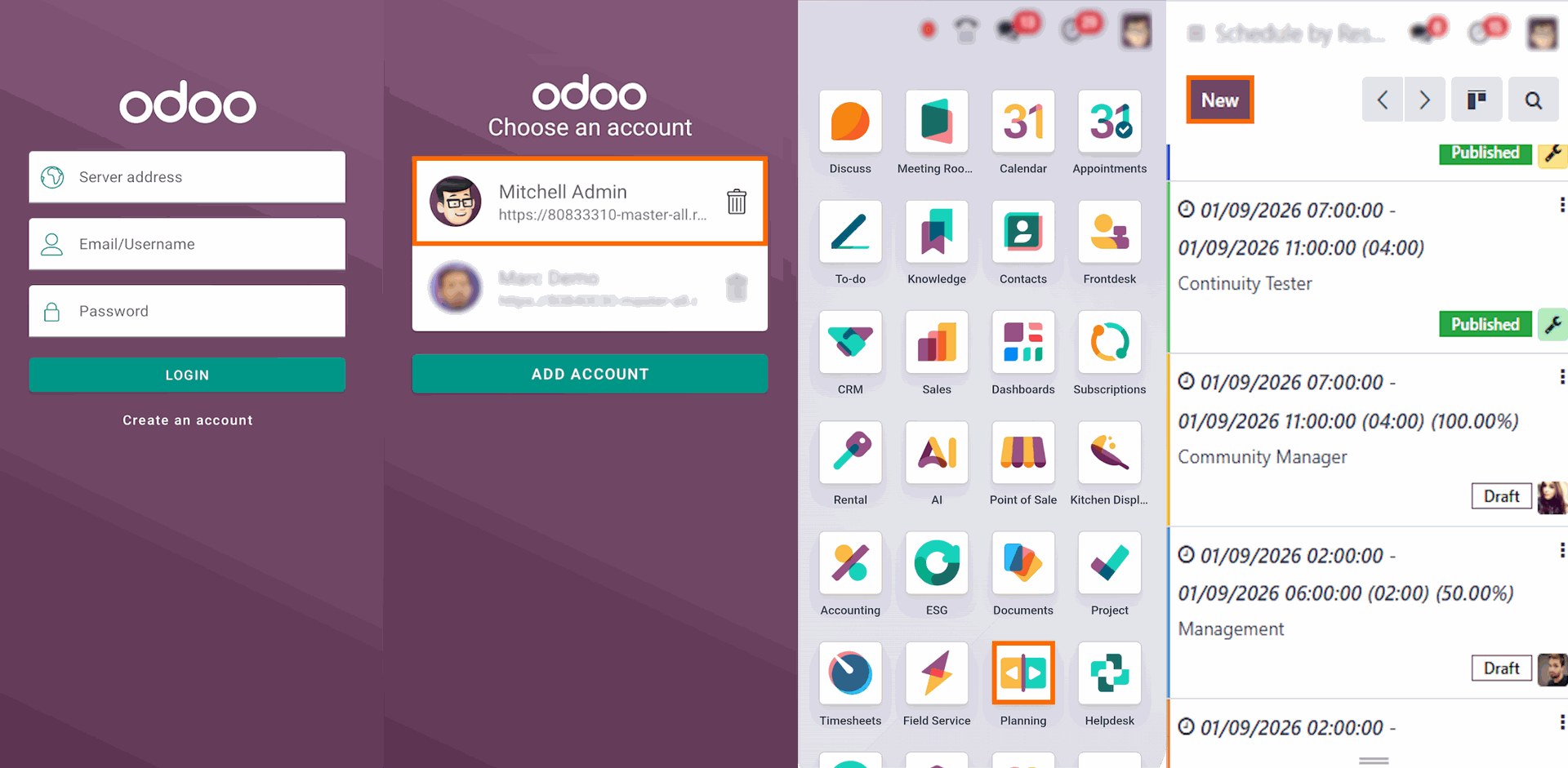
Odoo Planning Overview: Final Thoughts & Key
Takeaways from the Planning Module
Odoo planning is not just about a scheduling tool – it’s a strategic layer of workforce coordination, workload balancing, and operational agility. As a core part of the resource planning App, it provides a high-level overview of planning activities while offering granular control over day-to-day operations. Its real strength lies in the harmony between automation and manual control: routine assignments are handled by templates and smart rules, while critical decisions stay in human hands. This module empowers teams to go beyond static calendars and build living, dynamic schedules that reflect real-world complexity – factoring in human constraints, availability, skills, seasonality, and sudden changes. Whether you’re planning an app, coordinating global teams, or managing retail shifts, Odoo delivers a responsive operational model that adapts with your business. It’s a solution for those who don’t just manage shifts, but manage strategy.
Centralized & Integrated Resource Planning App
By integrating seamlessly with Timesheets, Time Off, Projects, and HR modules, it creates a unified environment where shift scheduling, task allocation, and employee availability work together in real time. This removes the need for disconnected spreadsheets or third-party tools, ensuring all planning decisions are based on up-to-date, synchronized data.
Manual & Automated Odoo Planning Flexibility
Odoo Production Planning stands out for its hybrid scheduling approach. Businesses can use fully manual Odoo scheduling when human context is essential or leverage automation for a recurring pattern, such as retail shifts or routine field service visits. The Auto Plan function applies rules, templates, and constraints to fill the schedule in seconds, while still giving managers final review and approval rights.
Real-Time Odoo Scheduling & Control
The module's Gantt and Calendar views offer instant clarity into who is doing what, when, and where — making it easier to detect Odoo scheduling conflicts, underutilized capacity, or last-minute absences. Color-coded shift blocks, role filters, and drag-and-drop controls turn workforce management from a guessing game into a live, actionable plan. Managers no longer need to chase updates by email or messengers — everything happens in real time, on one interface.
Smarter Use of Odoo Planning Templates
Odoo Planning supports skill-based and role-based allocation, helping managers move beyond assigning tasks by name and toward building schedules based on competencies and business needs. Built-in templates allow teams to plan once and reuse frequently, while capacity views and workload forecasts help spot overbooking or team imbalances early.
Odoo Planning Module for Resource Management
Whether you’re managing long-term project timelines or rotating hourly shifts across dozens of locations, the system offers the structure and agility to keep your workforce coordinated — even when plans change. By combining real-time insight, intelligent templates, flexible assignment logic, and full visibility, Odoo planning enables scaling operations with confidence and empowers companies to maintain control without micromanagement.
Conclusion
Odoo 18 Planning Module offers more than just visual scheduling – it serves as a strategic planning layer in your Odoo Project Management Documentation, ensuring every task aligns with real-time availability and departmental goals. Whether you’re reviewing planes Odoo has scheduled across teams or working with the WHS CMD Calendar to fine-tune shift allocation, centralized views simplify decisions. It also gives early visibility into capacity bottlenecks so managers can adjust before conflicts escalate.
With a clear Odoo roadmap, teams gain an actionable Odoo overview of current workloads and future capacity. This visibility helps prevent resource bottlenecks and minimizes plannings conflicts across interdependent operations. Odoo Planning also supports drag-and-drop rescheduling, enabling fast response to urgent changes without disrupting the broader project structure. From internal coordination to customer-facing services, the Odoo Appointment Management System transforms plannings into a connected, responsive process. Integration with employee calendars, task stages, and manufacturing workflows ensures every resource is utilized efficiently.
Odoo Planning becomes not just a scheduling solution, but a foundational layer in your operational strategy – aligning people, processes, and performance at scale. As a result: fewer missed shifts, better utilization, higher team satisfaction – and a planning process that evolves with your business.